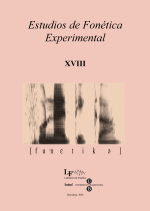Sonorización de las oclusivas sordas en una hablante murciana: problemas que plantea
Keywords:
voicing, approximationAbstract
This aim of this study is to present the suprising occurrences of the voicing of voiceless plosives by a Murcian speaker. A quantitive account is given of the frequency of consonants that remain plosives and those which appear as approximants. In 15.85 % of the cases an approximant was pronounced, and full voicing was present 74.39% of the time (58.54% in the cases of the plosives). In addition, 95.74 % of the occurrences of voicing were produced in a non-initial context and not following an «s» in the coda, since in these contexts a voiceless stop is usually produced. The study concludes with a perception test which highlights the confusion of informants between minimal pairs of voiceless-voiced sounds. Informants strongly favoured the voiced phoneme when the words appeared isolated whilst there was a noted lack of confusion when they appeared in phrases. It is suggested that since there is a neutralisation of the features of voicing, tension and duration, it is the context which is important for the final interpretation of the phrase.
References
ALMEIDA, M. y C. DÍAZ ALAYÓN (1988): El español de Canarias, Santa Cruz de Tenerife.
ALVAR, M. (1965): «Notas sobre el español hablado en La Graciosa (Canarias orientales)», RFE, XLVIII, pp. 293-319.
ALVAR, M. (1972): Niveles socioculturales en el habla de Las Palmas de Gran Canaria, Las Palmas de Gran Canaria, Edición del Excmo. Cabildo Insular.
BYBEE, J. (2001): Phonology and Language Use, Cambridge, Cambridge Universi- ty Press.
FLÓREZ, L. (1964): «El español hablado en Colombia y su Atlas lingüístico», Presente y futuro de la lengua española, I, Madrid, pp. 5-77.
GUITART, J. M. (2004): Sonido y sentido, Washington D. C, Georgetown Univer- sity Press.
HAYWARD, K. (2000): Experimental Phonetics, Harlow, England, Longman.
HENRÍQUEZ UREÑA, P. (1938): «Datos sobre el habla popular de Méjico», El español de Méjico, los Estados Unidos y la América Central, BDH, IV, Buenos Aires, pp. 277-327.
HERRERA, E. (2003): «La sonorité des occlusives en espagnol: une étude de perception», comunicación presentada en el XVII Intentional Congress of Linguists, Praga. 24-29 de julio. http://lef.colmex.ms/Fonetica/publicaciones/publicaciones.htm
HERRERA, J. (1989): «Sonorización de oclusivas sordas en Tenerife», en J. Dorta y J. Herrera (Eds): Tres estudios de Fonética, La Laguna, Universidad de La Laguna, pp. 111-121.
HUALDE, J. I. (2005): The Sounds of Spanish, Cambridge, Cambridge University Press.
I , C. (1968): El español en Cuba, Bucarest, Sociedad Rumana de Lingüística Románica.
JOHNSON, K. (2003): Acoustic & Auditory Phonetics, Oxford, Blackwell Publishing, segunda edición.
LEWIS, A. M. (2001): Weakening of intervocalic /p, t, k/ in two Spanish dialects: toward the quantification of lenition processes, tesis doctoral, University of Illinois at Urbana-Champaign.
LORENZO RAMOS, A. (1976): El habla de los Silos, Santa Cruz de Tenerife, Confederación Española de Cajas de Ahorro.
MACHUCA AYUSO, M. J. (1997): Las obstruyentes no continuas del español : relación entre las categorías fonéticas y fonológicas en el habla espontánea, tesis doctoral, Universitat Autònoma de Barcelona
MARTÍNEZ CELDRÁN, E. (1985): «Cantidad e intensidad en los sonidos obstruyentes del castellano: hacia una caracterización acústica de los sonidos aproxi- mantes», Estudios de Fonética Experimental, I, pp. 71-129.
MARTÍNEZ CELDRÁN, E. (1989): Fonología general y española, Barcelona, Teide.
MARTÍNEZ CELDRÁN, E. (1991a): «Tensión frente a sonoridad en las consonantes mates del castellano», Fonética experimental: teoría y práctica, Madrid, Síntesis, pp. 131-141.
MARTÍNEZ CELDRÁN, E. (1991b): «Duración y tensión en las oclusivas no iniciales del español: un estudio perceptivo», Revista Argentina de Lingüística, vol. 7, 1, pp. 51-71.
MARTÍNEZ CELDRÁN, E. (1997): «La duración de la nasal precedente como índice de la tensión de las oclusivas españolas», en R. Escavy et al (eds.): Homenaje al profesor A. Roldán Pérez, vol. I, Murcia, Universidad de Murcia, pp. 331-339.
MARTÍNEZ CELDRÁN, E. y A. Mª FERNÁNDEZ PLANAS (2007): Manual de fonética española. Articulaciones y sonidos del español, Barcelona, Ariel.
NAVARRO CORREA, M. (1982): El español hablado en Puerto Cabello, tesis doctoral inédita, Universidad de La Laguna.
OFTEDAL, M. (1985): Lenition in celtic and insular Spanish: the secondary voicing of stops in Gran Canaria, Oslo, Universitetsforlaget cop.
PÉREZ, H. E. (2001): «La noción de rasgo. El caso de las consonantes oclusivas del español», Onomazein, 6, pp. 327-336
SALVADOR, G. (1965): «Encuesta en Andiñuela», Archivum, XV, pp. 120-255. SALVADOR, G. (1968): «Neutralización de G-/K- en español», Actas del XI Congreso Internacional de Lingüística y Filología Románicas, IV, Madrid, pp. 1739-1752.
SOTO–BARBA, J. (1994): «¿Los fonemas /b/ y /p/ se diferencian por la sonoridad?», Estudios filológicos 29, pp. 33–37.
TORREBLANCA, M. (1976): «La sonorización de las oclusivas sordas en el habla toledana», Boletín de la Real Academia Española, tomo LVI, cuaderno CCVII, pp.117-165.
TORREBLANCA, M. (1979): «Un rasgo fonológico de la lengua española», Hispa- nic Review, 47, 1, pp. 455-468.
TOSCANO MATEUS, H. (1953): El español en el Ecuador, Madrid, CSIC.
TRUJILLO, R. (1980): «Sonorización de sordas en Canarias», en Anuario de Letras de la Universidad Nacional Autónoma de México, XVIII, México, pp. 247- 265.
TYLOR, J. R. (1989): Linguistic categorization. Prototypes in Linguistic Theory, Oxford, Clarendon Press.
VEIGA, A. (2002): Estudios de fonología funcional, A Coruña, Toxosoutos.
Downloads
Published
How to Cite
Issue
Section
License

This work is licensed under a Creative Commons Attribution-NonCommercial-NoDerivatives 4.0 International License.
All articles published online by Estudios de Fonética Experimental are licensed under Creative Commons Attribution-NonCommercial-NoDerivs 4.0 International (CC BY-NC-ND 4.0 DEED), unless otherwise noted. Estudios de Fonética Experimental is an open access journal. Estudios de Fonética Experimental is hosted by RCUB (Revistes Científiques de la Universitat de Barcelona), powered by Open Journal Systems (OJS) software. The copyright is not transferred to the journal: authors hold the copyright and publishing rights without restrictions. The author is free to use and distribute pre and post-prints versions of his/her article. However, preprint versions are regarded as a work-in-progress version used as internal communication with the authors, and we prefer to share postprint versions.




